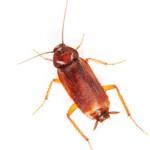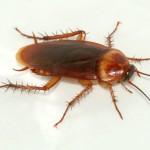Cockroach Control Information
Description
Cockroaches
A recent survey indicated that the cockroach was the most despised creature, beating out snakes, rats, bats, and spiders.
The German cockroach or Blatella Germanica is considered it to be a pest because it invades where we live, eat and sleep. Between 4000 to 7500 different species of roaches. Of this amount, only one percent is considered to be a pest. Some of the other more common species are
- Oriental Cockroach – Blatta Orientalis
- American Cockroach – Periplaneta Americana
- Brownbanded Cockroach – Supella Longipalpa
Their mouths are used for chewing, not biting. Most roaches are nocturnal, that is, they prefer the night and are sensitive to all forms of light except for the red spectrum. They are most active right after dusk and right before dawn. They prefer to live in warm moist places and are more abundant in tropical areas. However, they can live in almost any environment and they have been found in the North and South Poles.
Cockroach isolated on white
German Cockroach
 The German Cockroach is 5/8 inches in length and is brown in color. There are two prominent black stripes running down the broad shield behind the head. This nasty little guy will eat almost anything – even hair and fingernails. This insect is common in areas with access to food and water. The life cycle from egg to adult takes about a month, and populations can become huge if not kept under control.
The German Cockroach is 5/8 inches in length and is brown in color. There are two prominent black stripes running down the broad shield behind the head. This nasty little guy will eat almost anything – even hair and fingernails. This insect is common in areas with access to food and water. The life cycle from egg to adult takes about a month, and populations can become huge if not kept under control.
American Cockroaches
 The American cockroach is the largest of the common peridomestic cockroaches. It is also known as the Palmetto bug or water bug. As an adult, they are dark red/mahogany in color, with a yellowish border on the pronotum. This yellowish border may make the pronotum appear to have two spots in the middle. The body is typically one and one-quarter inches in length.
The American cockroach is the largest of the common peridomestic cockroaches. It is also known as the Palmetto bug or water bug. As an adult, they are dark red/mahogany in color, with a yellowish border on the pronotum. This yellowish border may make the pronotum appear to have two spots in the middle. The body is typically one and one-quarter inches in length.
More Information and Tips on Cockroaches Extermination
- Cockroaches, or “Roaches” are fast breeding, swift running, winged insects with spiny legs and long antennae
- Carry Salmonella and other bacteria
- May trigger asthmatic or allergic reactions
- May secrete foul-smelling matter
- Can live several years
- Can live 1 month without water and 3 months without food
- Lay hundreds of eggs each year
- If you have seen 1 in the daytime, you have hundreds!
- Can be brought home in grocery bags, cardboard boxes and on pop cases
- Nocturnal - will scatter when lights are turned on
- Prevention and Control - Thoroughly vacuum affected areas and clear areas
- Clean up any crumbs
- Store food in sealed containers
- Remove garbage daily to a container with a tight-fitting lid
- Do not leave dirty dishes overnight
- Clean up dog and cat feces
- Move wood and leaf piles away from the house
- Fix any leaks or dripping faucets
- Seal and fill any gaps or cracks around door frames and baseboards
- Be sure all doors, windows, and screens are tight-fitting
- Difficult to eliminate - need a professional to treat areas
- Most common in our area are Brown-banded, German and Wood Roaches
- All people and pets must vacate the premises for 4 - 6 hours
Details
| Date Added | 2019-03-26 |
| Product Id | 10461412 |






